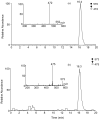Identification and quantification of a guanine-thymine intrastrand cross-link lesion induced by Cu(II)/H2O2/ascorbate
- PMID: 16696563
- PMCID: PMC2519820
- DOI: 10.1021/tx060025x
Identification and quantification of a guanine-thymine intrastrand cross-link lesion induced by Cu(II)/H2O2/ascorbate
Abstract
Reactive oxygen species (ROS) can be induced by both endogenous and exogenous processes, and they can damage biological molecules including nucleic acids. It was shown that X- or gamma-ray irradiation of aqueous solutions of DNA, during which *OH is one of the major ROS, can lead to the formation of intrastrand cross-link lesions where the neighboring nucleobases in the same DNA strand are covalently bonded. Previous 32P-postlabeling studies suggested that the intrastrand cross-link lesions may arise from Fenton reaction, which also induces the formation of *OH; the structures of the proposed intrastrand cross-link lesions, however, have not been determined. Here, we showed for the first time that the treatment of calf thymus DNA with Cu(II)/H2O2/ascorbate could lead to the formation of an intrastrand cross-link lesion, i.e., G wedge T, where the C8 of guanine is covalently bonded to the neighboring 3'-thymine through its methyl carbon. LC-MS/MS quantification results showed dose-responsive formation of G wedge T. In addition, the yield of the intrastrand cross-link was approximately 3 orders of magnitude lower than those of commonly observed single-base lesions, that is, 8-oxo-7,8-dihydro-2'-deoxyguanosine, 5-(hydroxymethyl)-2'-deoxyuridine, and 5-formyl-2'-deoxyuridine. The induction of intrastrand cross-link lesion in calf thymus DNA by Fenton reagents in vitro suggests that this type of lesion might be formed endogenously in mammalian cells.
Figures







Similar articles
-
Quantification of oxidative single-base and intrastrand cross-link lesions in unmethylated and CpG-methylated DNA induced by Fenton-type reagents.Nucleic Acids Res. 2007;35(14):4833-44. doi: 10.1093/nar/gkm497. Epub 2007 Jul 10. Nucleic Acids Res. 2007. PMID: 17626047 Free PMC article.
-
Formation and genotoxicity of a guanine-cytosine intrastrand cross-link lesion in vivo.Nucleic Acids Res. 2007;35(21):7118-27. doi: 10.1093/nar/gkm851. Epub 2007 Oct 16. Nucleic Acids Res. 2007. PMID: 17942427 Free PMC article.
-
In vivo formation and in vitro replication of a guanine-thymine intrastrand cross-link lesion.Biochemistry. 2007 Nov 6;46(44):12757-63. doi: 10.1021/bi7012195. Epub 2007 Oct 12. Biochemistry. 2007. PMID: 17929946
-
Recognition and incision of gamma-radiation-induced cross-linked guanine-thymine tandem lesion G[8,5-Me]T by UvrABC nuclease.Chem Res Toxicol. 2005 Sep;18(9):1339-46. doi: 10.1021/tx050147+. Chem Res Toxicol. 2005. PMID: 16167825 Free PMC article.
-
Generation of 5-(2'-deoxycytidyl)methyl radical and the formation of intrastrand cross-link lesions in oligodeoxyribonucleotides.Nucleic Acids Res. 2005 Mar 14;33(5):1593-603. doi: 10.1093/nar/gki301. Print 2005. Nucleic Acids Res. 2005. PMID: 15767284 Free PMC article.
Cited by
-
DNA damage by reactive species: Mechanisms, mutation and repair.J Biosci. 2012 Jul;37(3):503-17. doi: 10.1007/s12038-012-9218-2. J Biosci. 2012. PMID: 22750987 Review.
-
Quantification of oxidative single-base and intrastrand cross-link lesions in unmethylated and CpG-methylated DNA induced by Fenton-type reagents.Nucleic Acids Res. 2007;35(14):4833-44. doi: 10.1093/nar/gkm497. Epub 2007 Jul 10. Nucleic Acids Res. 2007. PMID: 17626047 Free PMC article.
-
Comprehensive DNA adduct analysis reveals pulmonary inflammatory response contributes to genotoxic action of magnetite nanoparticles.Int J Mol Sci. 2015 Feb 4;16(2):3474-92. doi: 10.3390/ijms16023474. Int J Mol Sci. 2015. PMID: 25658799 Free PMC article.
-
Formation and genotoxicity of a guanine-cytosine intrastrand cross-link lesion in vivo.Nucleic Acids Res. 2007;35(21):7118-27. doi: 10.1093/nar/gkm851. Epub 2007 Oct 16. Nucleic Acids Res. 2007. PMID: 17942427 Free PMC article.
-
Induction of 8,5'-cyclo-2'-deoxyadenosine and 8,5'-cyclo-2'-deoxyguanosine in isolated DNA by Fenton-type reagents.Chem Res Toxicol. 2013 Sep 16;26(9):1361-6. doi: 10.1021/tx400221w. Epub 2013 Sep 4. Chem Res Toxicol. 2013. PMID: 23961697 Free PMC article.
References
-
- Lindahl T. DNA lesions generated in vivo by reactive oxygen species, their accumulation and repair. NATO ASI Ser., Ser. A. 1999;302:251–257.
-
- Finkel T, Holbrook NJ. Oxidants, oxidative stress and the biology of ageing. Nature. 2000;408:239–247. - PubMed
-
- Marnett LJ. Oxyradicals and DNA damage. Carcinogenesis. 2000;21:361–370. - PubMed
-
- Feig DI, Reid TM, Loeb LA. Reactive oxygen species in tumorigenesis. Cancer Res. 1994;54:1890s–1894s. - PubMed
Publication types
MeSH terms
Substances
Grants and funding
LinkOut - more resources
Full Text Sources
Other Literature Sources
Medical

